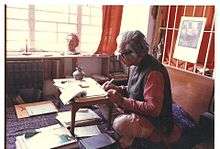Surajit Chandra Sinha
| Surajit Chandra Sinha | |
|---|---|
 Prof. Surajit Sinha working at his home in Shantiniketan. | |
| Born |
1926 Susang, Bengal, British India |
| Died |
27 February 2002 Santiniketan, West Bengal, India |
| Nationality | Indian |
| Occupation | Anthropologist, administrator |
| Religion | Hinduism |
| Spouse(s) | Purnima Sinha (nee Sengupta) |
| Relatives |
Mani Sinha (paternal uncle) Purba Dam (sister) |
Surajit Chandra Sinha (1926–27 February, 2002) was born in Durgapur Upazila, of Netrokona District, in Mymensingh Division, then in Bengal and now in Bangladesh. He was an Indian anthropologist.[1]
Background
He was the eldest son of Bhupendra Chandra Sinha, the Maharaja of Susang, who was a student of Presidency College, Calcutta and a well-known landscape painter. His mother was a daughter of Jogendranath Moitra, the zamindar of Sithlai in Pabna District. Her family could trace their origins to the reign of Emperor Jahangir. Sinha's youngest sister is Purba Dam, the eminent exponent of Rabindrasangeet.
A close paternal uncle, Maharajkumar Mani Singh was a well-known Communist Party leader who wrote Jiban Sangram. and was later elected head of the communist party of East Pakistan. In his youth he followed in the footsteps of this paternal uncle. His maternal uncle was Kumar Jyotirindra Moitra (popularly called "Botukda"), an eminent exponent of Rabindrasangeet, of the Sithlai family and who later wrote the school anthem for Patha Bhavan, Kolkata.
Sinha was married to Dr. Purnima Sinha, a physicist, author and music scholar, who was the daughter of the eminent legal scholar and Bengali novelist, Dr. Nares Chandra Sen-Gupta.
In the colonial period, his father's official status was third in protocol in the Government House of Calcutta after Coochbehar and the Burdwan. The Maharajas of Susang (a hill estate), were the most influential "zamindars" of Mymensingh division. The other major zamindars of the same division were the Maharajas of Muktagacha, who in spite of being the richest zamindars in the division, considered the chiefs of Susanga to be their chiefs.
Even though Sinha was brought up and worked in Calcutta for most part of his life, he spent several years (especially the last few years) in Santiniketan, where, from the beginning of the twentieth century, his family owned a house. The Sinha's of Susanga can be considered to be one of the prominent families of Santiniketan.
Education
After his education in a high school in Mymensingh and at Ballygunge Government High School, Calcutta, he started his college education in physics at Presidency College, Calcutta, but then changed to geology and then finally to anthropology. Nirmal Kumar Bose, the eminent anthropologist, became his mentor soon after they met in the viva examination for the master's degree, where Bose was one of the examiners. Later, Sinha completed his Ph.D. in anthropology from Northwestern University in Illinois, United States on a Fulbright Scholarship.
Career
He held a number of administrative posts such as deputy director and director of the Anthropological Survey of India in Calcutta. At this time he was considered to be an advisor of the then Indian prime minister, Indira Gandhi. He was the professor of anthropology at the Indian Institute of Management, Calcutta. He became the upacharya of Visva Bharati, Santiniketan. After retirement he became the second director of the Centre for Studies in Social Sciences, Calcutta.
Sinha distinguished himself in the field of social anthropology. Upon returning to India from the United States, he continued to conduct field research. His main area of interest were Indian tribes, especially the Bhumij tribe in central India.
Opinion
Sinha was committed to the ideologies of both Mahatma Gandhi and Rabindranath Tagore, arguably the two most eminent Indians in the nineteenth and the twentieth centuries. The difference between the views of these two men was that whereas Gandhi wanted every Indian to be (in the best sense) a Shudra, Tagore wanted every Indian to be (also in the best sense) a Brahmin.[2]
Death
He was diagnosed with Alzheimer's disease in 1993 and died after a prolonged illness in 2002.
He left behind a rich heritage of anthropological fields of research. He inspired a whole generation of Indian anthropologists and contributed significantly to understanding the process of acculturation of tribal people in India.
Publications
- Science, Technology, and Culture: A Study of the Cultural Traditions and Institutions of India and Ceylon in Relation to Science and Technology
- (ed.), Tribal Polities and State Systems in Pre-Colonial Eastern and North Eastern India, (Calcutta, 1987)
- Tribes and Indian Civilization: Structures and Transformation (Varanasi, 1982)
- (ed.), Ascetics of Kashi : An Anthropological Exploration, (co-edited with Baidyanath Saraswati) (Varanasi, 1978)
- (ed.), Field Studies on the People of India : Methods and Perspectives, (In Memory of Professor Tarak Chandra Das), (Calcutta, 1978)
- (ed.), Anthropology in India, Tribal Thought and Culture, (Calcutta, 1976) [3]
- (ed.), Aspects of Indian Culture and Society: Essays in Felicitation of Professor Nirmal Kumar Bose, (Calcutta, 1972)
- (ed.), Cultural Profile of Calcutta, (Calcutta, 1972)
- (ed.), Research Programmes on Cultural Anthropology and Allied Disciplines, (Calcutta, 1970)
- (ed.), Ethnic Groups, Villages, and Towns of Pargana Barabhum: Report of a Survey, (co-edited with Biman Kumar Dasgupta and Hemendranath Banerjee) (Calcutta, 1966)
- (ed.), Levels of a Economic Initiative and Ethnic Groups in Paragana Barabhum, (Durham, N.C., 1964)
See also
References
- ↑ https://vidyasagar.academia.edu/AbhijitGuha/Surajit-Sinha-Archive
- ↑ "A creeping Insularity – Santiniketan still has a living link with its founders". The Telegraph 12 April 2008. Retrieved 27 February 2009.
- ↑ "Sinha, Surajit 1926–". Retrieved 27 February 2009.